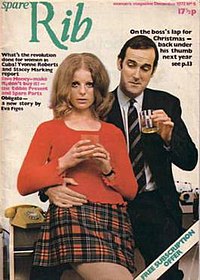Marsha Rowe

Spare Rib cover, December 1972; featuring John Cleese on the cover.
|
|
| Editor | Collective from late 1973 |
|---|---|
| Categories | Feminist Magazine |
| Year founded | 1972 |
| Final issue | 1993 |
| Country | United Kingdom |
| Language | English |
| Website | http://www.bl.uk/spare-rib (archive) |
Spare Rib was a second-wave feminist magazine in the United Kingdom that emerged from the counter culture of the late 1960s as a consequence of meetings involving, among others, Rosie Boycott and Marsha Rowe. Spare Rib is now recognised as an iconic magazine, and a place which shaped debate about feminism in the UK. It contained new writing and creative contributions which challenged stereotypes and supported collective solutions. The magazine existed between 1972 and 1993.
Spare Rib's first issue was published in June 1972. At the time, some newsagents refused to stock it, including W. H. Smith. Selling at first around 20,000 copies per month, it was circulated more widely through women's groups and networks.
Its purpose, as described in its editorial, was to investigate and present alternatives to the traditional gender roles for women of virgin, wife or mother.
The name Spare Rib started as a joke, with its play on words about the Biblical Eve fashioned out of Adam’s rib, implying that a woman had no independence from the beginning of time. This held the witty, subversive connotations the editors had been looking for.
The Spare Rib Manifesto stated:
"The concept of Women’s Liberation is widely misunderstood, feared and ridiculed. Many women remain isolated and unhappy. We want to publish Spare RIB to try to change this. We believe that women’s liberation is of vital importance to women now and, intrinsically, to the future of our society. Spare RIB will reach out to all women, cutting across material, economic and class barriers, to approach them as individuals in their own right".
Early articles were linked closely with left-leaning political theories of the time, especially anti-capitalism and the exploitation of women as consumers through fashion. The covers were often of a striking design.
As the women's movement evolved during the 1970s, the magazine became a focus for sometimes acrimonious debate between the many streams that emerged within the movement, such as socialist feminism, radical feminism, revolutionary feminism, lesbian feminism, liberal feminism and black feminism. It included contributors from well-known international feminist writers, activists and theorists as well as the stories of ordinary women in their own words.
...
Wikipedia
